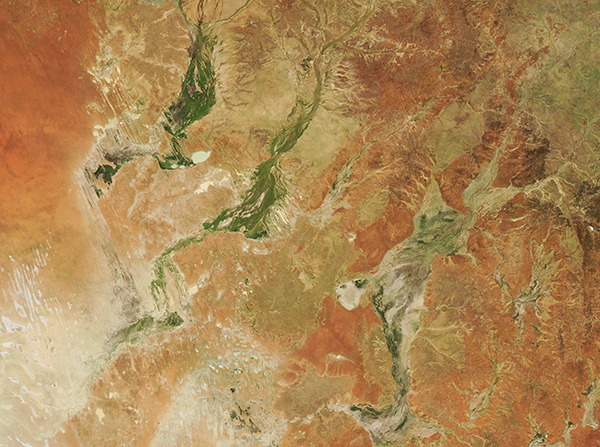Images
April 12, 2024 - Australia's Channel Country
Tweet
In Queensland, fierce storms in January brought stunning greening to Australia’s Channel Country in April.
In late January and early February 2024, Queensland received a major drenching from Tropical Cyclone Kirrily. According to the Queensland Government website, a meter of rain (3.3 feet) fell in the northern part of the state near landfall on January 25. Then, between January 29-30, more than 300 mm (11 inches) fell in southeast Queensland. Additional soaking occurred from the storm’s remnants and from moisture-laden low pressure systems in the region through late February.
Since mid-February, stormwater has been moving slowly southward through Australia’s Channel Country, covering about 8-10 kilometers (5-6.2 miles) per day, according to the Australia Bureau of Meteorology (BoM), ultimately heading to South Australia’s Lake Eyre. The Channel Country bioregion is made up of a vast area of arid and semi-arid land across parts of Queensland, South Australia, Northern Territory, and New South Wales, with about seventy percent found in southwestern Queensland. Most of the crisscrossing channels are ephemeral, filling with water only in heavy flood conditions.
On April 10, 2024, the Moderate Resolution Imaging Spectroradiometer (MODIS) acquired a true-color image of greening along the Georgina, Diamantina, and Coopers Creek Rivers in the Queensland portion of Australia’s Channel Country.
Floodwaters reached these rivers by March 19, according to the BoM, and continued to creep southward. By April 9, water had reached the northern tip of Kati Thanda-Lake Eyre (located south of this image). Meanwhile, the arid lands surrounding the Channel Country rivers had burst forth in glorious green vegetation.
Image Facts
Satellite:
Aqua
Date Acquired: 4/10/2024
Resolutions:
1km (522.3 KB), 500m (1.4 MB), 250m (3.4 MB)
Bands Used: 1,4,3
Image Credit:
MODIS Land Rapid Response Team, NASA GSFC
Tweet
In Queensland, fierce storms in January brought stunning greening to Australia’s Channel Country in April.
In late January and early February 2024, Queensland received a major drenching from Tropical Cyclone Kirrily. According to the Queensland Government website, a meter of rain (3.3 feet) fell in the northern part of the state near landfall on January 25. Then, between January 29-30, more than 300 mm (11 inches) fell in southeast Queensland. Additional soaking occurred from the storm’s remnants and from moisture-laden low pressure systems in the region through late February.
Since mid-February, stormwater has been moving slowly southward through Australia’s Channel Country, covering about 8-10 kilometers (5-6.2 miles) per day, according to the Australia Bureau of Meteorology (BoM), ultimately heading to South Australia’s Lake Eyre. The Channel Country bioregion is made up of a vast area of arid and semi-arid land across parts of Queensland, South Australia, Northern Territory, and New South Wales, with about seventy percent found in southwestern Queensland. Most of the crisscrossing channels are ephemeral, filling with water only in heavy flood conditions.
On April 10, 2024, the Moderate Resolution Imaging Spectroradiometer (MODIS) acquired a true-color image of greening along the Georgina, Diamantina, and Coopers Creek Rivers in the Queensland portion of Australia’s Channel Country.
Floodwaters reached these rivers by March 19, according to the BoM, and continued to creep southward. By April 9, water had reached the northern tip of Kati Thanda-Lake Eyre (located south of this image). Meanwhile, the arid lands surrounding the Channel Country rivers had burst forth in glorious green vegetation.
Image Facts
Satellite:
Aqua
Date Acquired: 4/10/2024
Resolutions:
1km (522.3 KB), 500m (1.4 MB), 250m (3.4 MB)
Bands Used: 1,4,3
Image Credit:
MODIS Land Rapid Response Team, NASA GSFC




